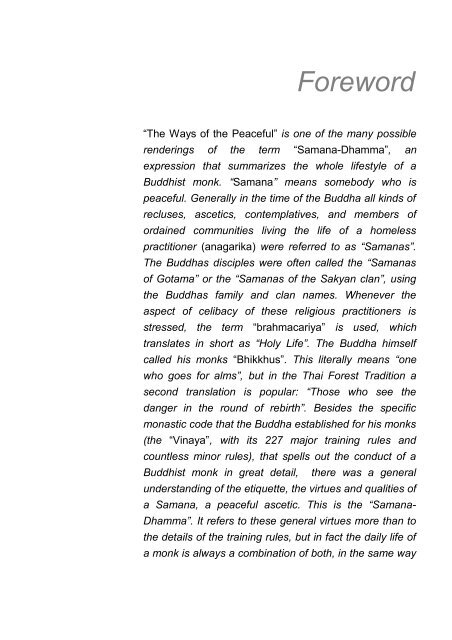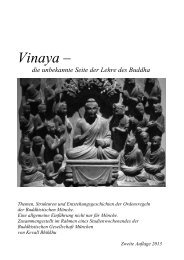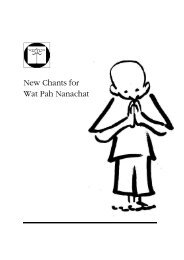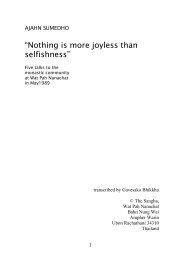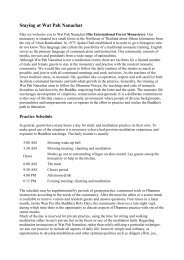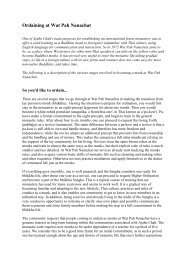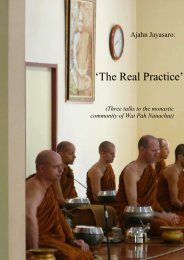Luang Por Liem: The Ways of the Peaceful - Wat Pah Nanachat
Luang Por Liem: The Ways of the Peaceful - Wat Pah Nanachat
Luang Por Liem: The Ways of the Peaceful - Wat Pah Nanachat
You also want an ePaper? Increase the reach of your titles
YUMPU automatically turns print PDFs into web optimized ePapers that Google loves.
Foreword<br />
“<strong>The</strong> <strong>Ways</strong> <strong>of</strong> <strong>the</strong> <strong>Peaceful</strong>” is one <strong>of</strong> <strong>the</strong> many possible<br />
renderings <strong>of</strong> <strong>the</strong> term “Samana-Dhamma”, an<br />
expression that summarizes <strong>the</strong> whole lifestyle <strong>of</strong> a<br />
Buddhist monk. “Samana” means somebody who is<br />
peaceful. Generally in <strong>the</strong> time <strong>of</strong> <strong>the</strong> Buddha all kinds <strong>of</strong><br />
recluses, ascetics, contemplatives, and members <strong>of</strong><br />
ordained communities living <strong>the</strong> life <strong>of</strong> a homeless<br />
practitioner (anagarika) were referred to as “Samanas”.<br />
<strong>The</strong> Buddhas disciples were <strong>of</strong>ten called <strong>the</strong> “Samanas<br />
<strong>of</strong> Gotama” or <strong>the</strong> “Samanas <strong>of</strong> <strong>the</strong> Sakyan clan”, using<br />
<strong>the</strong> Buddhas family and clan names. Whenever <strong>the</strong><br />
aspect <strong>of</strong> celibacy <strong>of</strong> <strong>the</strong>se religious practitioners is<br />
stressed, <strong>the</strong> term “brahmacariya” is used, which<br />
translates in short as “Holy Life”. <strong>The</strong> Buddha himself<br />
called his monks “Bhikkhus”. This literally means “one<br />
who goes for alms”, but in <strong>the</strong> Thai Forest Tradition a<br />
second translation is popular: “Those who see <strong>the</strong><br />
danger in <strong>the</strong> round <strong>of</strong> rebirth”. Besides <strong>the</strong> specific<br />
monastic code that <strong>the</strong> Buddha established for his monks<br />
(<strong>the</strong> “Vinaya”, with its 227 major training rules and<br />
countless minor rules), that spells out <strong>the</strong> conduct <strong>of</strong> a<br />
Buddhist monk in great detail, <strong>the</strong>re was a general<br />
understanding <strong>of</strong> <strong>the</strong> etiquette, <strong>the</strong> virtues and qualities <strong>of</strong><br />
a Samana, a peaceful ascetic. This is <strong>the</strong> “Samana-<br />
Dhamma”. It refers to <strong>the</strong>se general virtues more than to<br />
<strong>the</strong> details <strong>of</strong> <strong>the</strong> training rules, but in fact <strong>the</strong> daily life <strong>of</strong><br />
a monk is always a combination <strong>of</strong> both, in <strong>the</strong> same way


